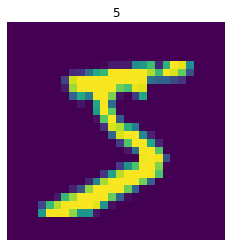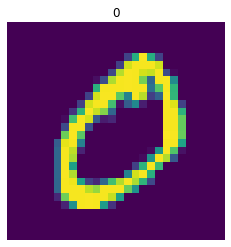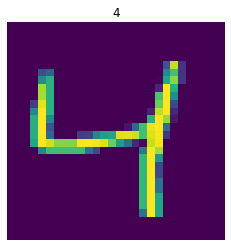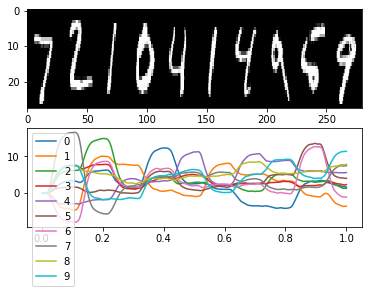- Overview
- Installation
- Configuration
- Example models
- Communication channel
- Integrator
- Multidimensional integrator
- Simple oscillator
- Nonlinear oscillator
- Neuron to neuron connections
- PES learning
- Keyword spotting
- MNIST convolutional network
- CIFAR-10 convolutional network
- Converting a Keras model to an SNN on Loihi
- Nonlinear adaptive control
- Legendre Memory Units on Loihi
- DVS from file
- API reference
- Tips and tricks
- Hardware setup
MNIST convolutional network¶
In this example we will show how to build and train a convolutional network in NengoDL, and then deploy that network on Loihi.
We’ll use the basic MNIST dataset to demonstrate the steps. The input data are images of handwritten digits, and the goal is for the network to classify each image as 0-9.
We will assume here that the reader is somewhat familiar with NengoDL, and focus on the issue of how to use NengoDL to train a network for Loihi. For a more basic introduction to NengoDL, check out the documentation and examples.
[1]:
%matplotlib inline
import os
import nengo
import nengo_dl
import numpy as np
import matplotlib.pyplot as plt
import tensorflow as tf
try:
import requests
has_requests = True
except ImportError:
has_requests = False
import nengo_loihi
[2]:
# helper function for later
def download(fname, drive_id):
"""Download a file from Google Drive.
Adapted from https://stackoverflow.com/a/39225039/1306923
"""
def get_confirm_token(response):
for key, value in response.cookies.items():
if key.startswith("download_warning"):
return value
return None
def save_response_content(response, destination):
CHUNK_SIZE = 32768
with open(destination, "wb") as f:
for chunk in response.iter_content(CHUNK_SIZE):
if chunk: # filter out keep-alive new chunks
f.write(chunk)
if os.path.exists(fname):
return
if not has_requests:
link = "https://drive.google.com/open?id=%s" % drive_id
raise RuntimeError(
"Cannot find '%s'. Download the file from\n %s\n"
"and place it in %s." % (fname, link, os.getcwd())
)
url = "https://docs.google.com/uc?export=download"
session = requests.Session()
response = session.get(url, params={"id": drive_id}, stream=True)
token = get_confirm_token(response)
if token is not None:
params = {"id": drive_id, "confirm": token}
response = session.get(url, params=params, stream=True)
save_response_content(response, fname)
# load mnist dataset
(train_images, train_labels), (
test_images,
test_labels,
) = tf.keras.datasets.mnist.load_data()
# flatten images
train_images = train_images.reshape((train_images.shape[0], -1))
test_images = test_images.reshape((test_images.shape[0], -1))
# plot some examples
for i in range(3):
plt.figure()
plt.imshow(np.reshape(train_images[i], (28, 28)))
plt.axis("off")
plt.title(str(train_labels[i]))



We’ll begin by defining a simple function to build a “convolutional layer”. This is just a nengo.Connection and nengo.Ensemble put together, but we’ll be doing this a lot so we’ll use this function to put them together in an easy-to-use bundle.
[3]:
def conv_layer(x, *args, activation=True, **kwargs):
# create a Conv2D transform with the given arguments
conv = nengo.Convolution(*args, channels_last=False, **kwargs)
if activation:
# add an ensemble to implement the activation function
layer = nengo.Ensemble(conv.output_shape.size, 1).neurons
else:
# no nonlinearity, so we just use a node
layer = nengo.Node(size_in=conv.output_shape.size)
# connect up the input object to the new layer
nengo.Connection(x, layer, transform=conv)
# print out the shape information for our new layer
print("LAYER")
print(conv.input_shape.shape, "->", conv.output_shape.shape)
return layer, conv
Next we define the structure of our network. Because we need to keep the number of neurons and axons per core below the Loihi hardware limits, we adopt a somewhat unusual network architecture. We’ll have a relatively small core network, so that each layer fits on one Loihi core, and then repeat that network several times in parallel, summing their output. We can think of this as a variation on ensemble learning. See the CIFAR-10 example for a different approach that uses NengoLoihi’s BlockShape functionality to automatically split larger layers across cores.
[4]:
dt = 0.001 # simulation timestep
presentation_time = 0.1 # input presentation time
max_rate = 100 # neuron firing rates
# neuron spike amplitude (scaled so that the overall output is ~1)
amp = 1 / max_rate
# input image shape
input_shape = (1, 28, 28)
n_parallel = 2 # number of parallel network repetitions
with nengo.Network(seed=0) as net:
# set up the default parameters for ensembles/connections
nengo_loihi.add_params(net)
net.config[nengo.Ensemble].neuron_type = nengo.SpikingRectifiedLinear(amplitude=amp)
net.config[nengo.Ensemble].max_rates = nengo.dists.Choice([max_rate])
net.config[nengo.Ensemble].intercepts = nengo.dists.Choice([0])
net.config[nengo.Connection].synapse = None
# the input node that will be used to feed in input images
inp = nengo.Node(
nengo.processes.PresentInput(test_images, presentation_time), size_out=28 * 28
)
# the output node provides the 10-dimensional classification
out = nengo.Node(size_in=10)
# build parallel copies of the network
for _ in range(n_parallel):
layer, conv = conv_layer(
inp, 1, input_shape, kernel_size=(1, 1), init=np.ones((1, 1, 1, 1))
)
# first layer is off-chip to translate the images into spikes
net.config[layer.ensemble].on_chip = False
layer, conv = conv_layer(layer, 6, conv.output_shape, strides=(2, 2))
layer, conv = conv_layer(layer, 24, conv.output_shape, strides=(2, 2))
nengo.Connection(layer, out, transform=nengo_dl.dists.Glorot())
out_p = nengo.Probe(out, label="out_p")
out_p_filt = nengo.Probe(out, synapse=nengo.Alpha(0.01), label="out_p_filt")
LAYER
(1, 28, 28) -> (1, 28, 28)
LAYER
(1, 28, 28) -> (6, 13, 13)
LAYER
(6, 13, 13) -> (24, 6, 6)
LAYER
(1, 28, 28) -> (1, 28, 28)
LAYER
(1, 28, 28) -> (6, 13, 13)
LAYER
(6, 13, 13) -> (24, 6, 6)
The next step is to optimize the parameters of the network using NengoDL.
First we set up the input/target data for the training and test datasets.
[5]:
# set up training data, adding the time dimension (with size 1)
minibatch_size = 200
train_images = train_images[:, None, :]
train_labels = train_labels[:, None, None]
# for the test data evaluation we'll be running the network over time
# using spiking neurons, so we need to repeat the input/target data
# for a number of timesteps (based on the presentation_time)
n_steps = int(presentation_time / dt)
test_images = np.tile(test_images[: minibatch_size * 2, None, :], (1, n_steps, 1))
test_labels = np.tile(test_labels[: minibatch_size * 2, None, None], (1, n_steps, 1))
Next we need to define our error functions.
For training we will use the standard categorical cross-entropy loss function.
For evaluation we will use classification accuracy (the % of images classified correctly) as an intuitive measure of how well the network is doing. Since we will be running the network over time during evaluation, we modify the loss function slightly so that it only assesses the accuracy on the last timestep.
[6]:
def classification_accuracy(y_true, y_pred):
return 100 * tf.metrics.sparse_categorical_accuracy(y_true[:, -1], y_pred[:, -1])
Now we create the NengoDL simulator and run the training using the sim.fit function.
More details on how to use NengoDL to optimize a model can be found here: https://www.nengo.ai/nengo-dl/user-guide.html.
To speed up this example we can set do_training=False to load some pre-trained parameters. If you have the requests package installed, we will download these automatically. If not, download the following file to the directory containing this notebook.
Note that in order to run do_training=True, you will need to have TensorFlow installed with GPU support.
[7]:
do_training = False
with nengo_dl.Simulator(net, minibatch_size=minibatch_size, seed=0) as sim:
if do_training:
sim.compile(loss={out_p_filt: classification_accuracy})
print(
"accuracy before training: %.2f%%"
% sim.evaluate(test_images, {out_p_filt: test_labels}, verbose=0)["loss"]
)
# run training
sim.compile(
optimizer=tf.optimizers.RMSprop(0.001),
loss={out_p: tf.losses.SparseCategoricalCrossentropy(from_logits=True)},
)
sim.fit(train_images, train_labels, epochs=5)
sim.compile(loss={out_p_filt: classification_accuracy})
print(
"accuracy after training: %.2f%%"
% sim.evaluate(test_images, {out_p_filt: test_labels}, verbose=0)["loss"]
)
sim.save_params("./mnist_params")
else:
download("mnist_params.npz", "1geZoS-Nz-u_XeeDv3cdZgNjUxDOpgXe5")
sim.load_params("./mnist_params")
# store trained parameters back into the network
sim.freeze_params(net)
Build finished in 0:00:00
Optimization finished in 0:00:00
| Constructing graph: pre-build stage (0%) | ETA: --:--:--
/home/travis/virtualenv/python3.6.7/lib/python3.6/site-packages/nengo_dl/simulator.py:461: UserWarning: No GPU support detected. See https://www.nengo.ai/nengo-dl/installation.html#installing-tensorflow for instructions on setting up TensorFlow with GPU support.
"No GPU support detected. See "
/home/travis/virtualenv/python3.6.7/lib/python3.6/site-packages/nengo_dl/transform_builders.py:53: UserWarning: TensorFlow does not support convolution with channels_last=False on the CPU; inputs will be transformed to channels_last=True
UserWarning,
Construction finished in 0:00:00
As we built it, the network has no synaptic filters on the neural connections. This works well during training, but we can see that the error is still somewhat high when we evaluate it using spiking neurons. We can improve performance by adding synaptic filters to our trained network.
[8]:
for conn in net.all_connections:
conn.synapse = 0.005
if do_training:
with nengo_dl.Simulator(net, minibatch_size=minibatch_size) as sim:
sim.compile(loss={out_p_filt: classification_accuracy})
print(
"accuracy w/ synapse: %.2f%%"
% sim.evaluate(test_images, {out_p_filt: test_labels}, verbose=0)["loss"]
)
Now we can load our trained network, with synaptic filters, onto Loihi. This is as easy as passing the network to nengo_loihi.Simulator and running it, there is no extra work required. We will give the network 50 test images, and use that to evaluate the classification error.
[9]:
n_presentations = 50
# if running on Loihi, increase the max input spikes per step
hw_opts = dict(snip_max_spikes_per_step=120)
with nengo_loihi.Simulator(
net,
dt=dt,
precompute=False,
hardware_options=hw_opts,
) as sim:
# run the simulation on Loihi
sim.run(n_presentations * presentation_time)
# check classification accuracy
step = int(presentation_time / dt)
output = sim.data[out_p_filt][step - 1 :: step]
correct = 100 * np.mean(
np.argmax(output, axis=-1) == test_labels[:n_presentations, -1, 0]
)
print("loihi accuracy: %.2f%%" % correct)
/home/travis/build/nengo/nengo-loihi/nengo_loihi/builder/ensemble.py:157: UserWarning: NengoLoihi does not support initial values for 'voltage' being non-zero on SpikingRectifiedLinear neurons. On the chip, all values will be initialized to zero.
% (key, type(neuron_type).__name__)
/home/travis/build/nengo/nengo-loihi/nengo_loihi/simulator.py:148: UserWarning: Model is precomputable. Setting precompute=False may slow execution.
"Model is precomputable. Setting precompute=False may slow execution."
loihi accuracy: 98.00%
We can also plot the output activity from the Loihi network as we show it different test images, to see what this performance looks like in practice.
[10]:
n_plots = 10
plt.figure()
plt.subplot(2, 1, 1)
images = test_images.reshape(-1, 28, 28, 1)[::step]
ni, nj, nc = images[0].shape
allimage = np.zeros((ni, nj * n_plots, nc), dtype=images.dtype)
for i, image in enumerate(images[:n_plots]):
allimage[:, i * nj : (i + 1) * nj] = image
if allimage.shape[-1] == 1:
allimage = allimage[:, :, 0]
plt.imshow(allimage, aspect="auto", interpolation="none", cmap="gray")
plt.subplot(2, 1, 2)
plt.plot(sim.trange()[: n_plots * step], sim.data[out_p_filt][: n_plots * step])
plt.legend(["%d" % i for i in range(10)], loc="best")
[10]:
<matplotlib.legend.Legend at 0x7f8b33e772b0>
